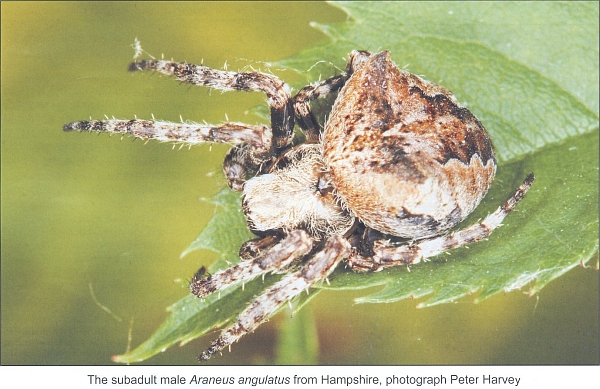Araneus angulatus in a garden in Hampshire
Extract from the Newsletter of the British arachnological Society
Spider Redording Scheme News. July 2006, no 55
I was first alerted to the possible presence of Araneus angulatus in my garden near Basingstoke in VC12 when a specimen was found (but never formally identified) at a moth trapping evening in July 2003. Its web was large (like so many orb-web spiders I hear you cry!), stretching between two hedges. I've been on the lookout ever since and the large web was all I had to go on. Perseverance paid off when I noticed a large web spanning a gap of about 1 metre between two leylandii hedges in late May this year. I traced the web into the hedge and sure enough there was a spider that looked awfully like A. angulatus. I watched it over the next few days and examined it in situ with a hand lens, becoming more and more convinced of its identity. Meanwhile I continued to search my garden for other evidence of this spider in the belief that it was unlikely that there would only be one specimen. Again, it was the web, this time stretching from another leylandii hedge across to tall plants in a wild flower area, which gave away the presence of the second of these spiders.
This time I wanted confirmation. So a bit of internet searching brought me to the Spider Recording Scheme and Peter Harvey. Peter was, understandably, rather sceptical when he received my email. Undeterred by his suggestion that this was a variant garden spider I badgered him with more details until he offered to identify a live specimen for me. A spider was duly posted to him and I was thrilled to receive his confirmation that it was Araneus angulatus, only the 12th record since 1991 and a first for a garden. On its return I was able to return the spider to the exact spot he had been taken from and as I write, 10 days later, he is still there.
Notes and observations:
Both spiders were found on the north faces of separate leylandii hedges. These hedges act as windbreaks from the prevailing southwest winds. They are trimmed annually so that they remain at about 7 feet tall by about 18 inches deep. My guess is that they are approximately 20 years old and they are about 700 metres long in total. One spider was found at a height of about 5 feet 6 inches, the other lower at around 2 feet 6 inches.
The garden extends to approximately 3 acres and comprises areas of short-mown grass (lawn is too grand a title for my weed infested grass!), large areas of rough pasture grass, leylandii hedging, mature yew and beech hedges, flower beds, shrubs and mature trees (oak, horse chestnut, whitebeam, holly, bird cherry, plane). In two areas the rough pasture grass has been allowed to grow, creating wild flower areas; these are cut once annually. No pesticides have been used on the garden in the last 6 years.
The garden is surrounded on three sides by paddocks; on two sides these are in organic conversion and are grazed by cattle.
I have noted during the time that I have been watching the spiders (only one since 16th June) that there is little evidence of web spinning on a regular basis I assumed that a new web would be made each night but the occurrence seems to be much less frequent than this maybe only once a week. Is this normal? Each spider has a few strands of web covering a small area of the hedge where they reside; could these act as triggers for an ambush attack?

Shirley Cardus
